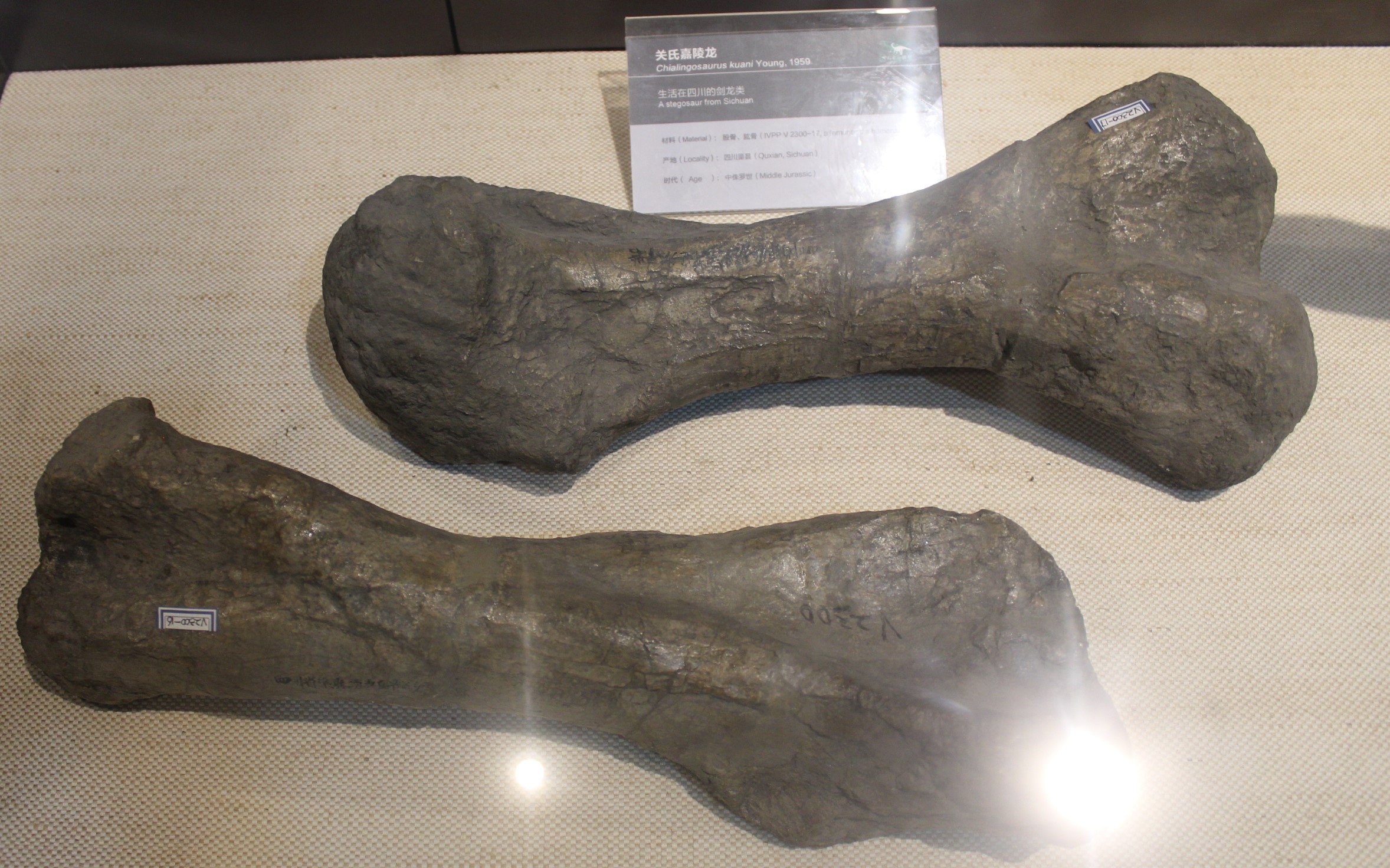Chialingosaurus on:
[Wikipedia]
[Google]
[Amazon]
''Chialingosaurus'' (meaning " Chialing Lizard") is a
 The
The
genus
Genus (; : genera ) is a taxonomic rank above species and below family (taxonomy), family as used in the biological classification of extant taxon, living and fossil organisms as well as Virus classification#ICTV classification, viruses. In bino ...
of herbivorous stegosauria
Stegosauria is a group of Herbivore, herbivorous ornithischian dinosaurs that lived during the Jurassic and early Cretaceous Period (geology), periods. Stegosaurian fossils have been found mostly in the Northern Hemisphere (North America, Europe a ...
n dinosaur
Dinosaurs are a diverse group of reptiles of the clade Dinosauria. They first appeared during the Triassic Geological period, period, between 243 and 233.23 million years ago (mya), although the exact origin and timing of the #Evolutio ...
similar to ''Kentrosaurus
''Kentrosaurus'' ( ; ) is a genus of stegosaurid dinosaur from the Late Jurassic in Lindi Region of Tanzania. The type species is ''K. aethiopicus'', named and described by German people, German Palaeontology, palaeontologist Edwin Hennig in 191 ...
'' from the Upper Shaximiao Formation
The Shaximiao Formation () is a Middle to Late Jurassic aged geological formation in Sichuan, China, most notable for the wealth of dinosaurs fossils that have been excavated from its strata. The Shaximiao Formation is exposed in and around the ...
, Late Jurassic
The Late Jurassic is the third Epoch (geology), epoch of the Jurassic Period, and it spans the geologic time scale, geologic time from 161.5 ± 1.0 to 143.1 ± 0.8 million years ago (Ma), which is preserved in Upper Jurassic stratum, strata.Owen ...
beds in Sichuan
Sichuan is a province in Southwestern China, occupying the Sichuan Basin and Tibetan Plateau—between the Jinsha River to the west, the Daba Mountains to the north, and the Yunnan–Guizhou Plateau to the south. Its capital city is Cheng ...
Province in China
China, officially the People's Republic of China (PRC), is a country in East Asia. With population of China, a population exceeding 1.4 billion, it is the list of countries by population (United Nations), second-most populous country after ...
. Its age makes it one of the oldest species of stegosaurs, living about 160 million years ago. Since it was an herbivore
A herbivore is an animal anatomically and physiologically evolved to feed on plants, especially upon vascular tissues such as foliage, fruits or seeds, as the main component of its diet. These more broadly also encompass animals that eat ...
, scientists think that ''Chialingosaurus'' probably ate ferns and cycads
Cycads are seed plants that typically have a stout and woody (ligneous) trunk with a crown of large, hard, stiff, evergreen and (usually) pinnate leaves. The species are dioecious, that is, individual plants of a species are either male or ...
, which were plentiful during the period when ''Chialingosaurus'' was alive.
Discovery and species
The fossils of ''Chialingosaurus'' were collected by the geologist Kuan Yaowu or Guan Yao-Wu in 1957, at Taipingstai in Quxian County, while surveying the Chialing River in southern China. Thetype species
In International_Code_of_Zoological_Nomenclature, zoological nomenclature, a type species (''species typica'') is the species name with which the name of a genus or subgenus is considered to be permanently taxonomically associated, i.e., the spe ...
''Chialingosaurus kuani'' was named and described by paleontologist Yang Zhongjian
Yang Zhongjian, also Yang Chung-chien (; 1 June 1897 – 15 January 1979), courtesy name Keqiang (), also known as C.C. (Chung Chien) Young, was a Chinese paleontologist and zoologist. He was one of China's foremost vertebrate paleontologists. ...
, ("C. C. Young") two years later in 1959. The generic name refers to the Chialing. The specific name honours Kuan. ''Chialingosaurus'' was the first stegosaurian described from China.C.-C. Young, 1959, "On a new Stegosauria from Szechuan, China", ''Vertebrata PalAsiatica'' 3(1): 1-8
 The
The holotype
A holotype (Latin: ''holotypus'') is a single physical example (or illustration) of an organism used when the species (or lower-ranked taxon) was formally described. It is either the single such physical example (or illustration) or one of s ...
, IVPP 2300, was found in a layer of the Upper Shaximiao Formation, dating from the Oxfordian-Kimmeridgian
In the geologic timescale, the Kimmeridgian is an age in the Late Jurassic Epoch and a stage in the Upper Jurassic Series. It spans the time between 154.8 ±0.8 Ma and 149.2 ±0.7 Ma (million years ago). The Kimmeridgian follows the Oxfordian ...
. It consists of a partial skeleton lacking the skull. It contains six vertebrae, the coracoids, the humeri, a right radius and three spines. The original material has been supplemented after November 1978 by Zhou Shiwu of the Municipal Museum of Chongqing. A second specimen, CV 202, was referred. It represents a skeleton with a partial skull and lower jaws, some vertebrae and limb elements, and four plates. Zhou considered it likely that the holotype and CV 202 represented a single individual, as the material was not overlapping. A third specimen, CV 203, a partial skeleton lacking the skull, was made the paratype
In zoology and botany, a paratype is a specimen of an organism that helps define what the scientific name of a species and other taxon actually represents, but it is not the holotype (and in botany is also neither an isotype (biology), isotype ...
. All specimens are juvenile or subadult.
In 1999, Li Kui Li Kui may refer to:
*Li Kui (legalist), government minister in the Wei state
*Li Kui (chancellor), chancellor of the Tang Dynasty
*Li Kui (Water Margin), fictional character in the ''Water Margin''
{{hndis, Li, Kui